List of African cuisines
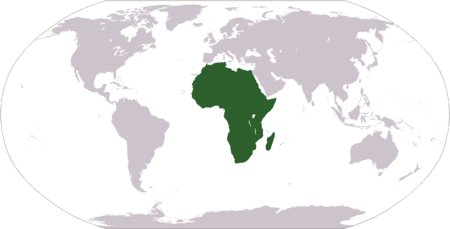
This is a list of African cuisines. A cuisine is a characteristic style of cooking practices and traditions,[1] often associated with a specific culture. The various cuisines of Africa use a combination of locally available fruits, cereal grains and vegetables, as well as milk and meat products. In some parts of the continent, the traditional diet features a preponderance of milk, curd and whey products. The continent's diverse demographic makeup is reflected in the many different eating and drinking habits, dishes, and preparation techniques of its manifold populations.[2]
Central African cuisine
- The cuisine of Central Africa remains largely traditional because of the remote nature of the region,[3] which remained relatively isolated until the 19th century.[3] Some foods, such as cassava (a food staple in Central Africa), groundnuts (peanuts) and chili peppers were imported from the New World.[3] Plantains are also common in Central African cuisine.[3] Meats, such as crocodile, antelope, monkey and warthog, are sometimes hunted in the forests.[3] Bambra is a porridge made from cooked rice, peanut butter and sugar.[3] A jomba is the bundling of foods in fresh green plantain leaves and then cooking them over hot coals or fire.[4]
- Cameroonian cuisine is one of the most varied in Africa due to its location on the crossroads between the north, west, and center of the continent; added to this is the profound influence of French food, a legacy of the colonial era.
- Congolese cuisine (Democratic Republic of the Congo) cuisine varies widely, representing the food of indigenous people. Cassava is generally the staple food usually eaten with other side dishes.
- Centrafrican cuisine in the Central African Republic includes Middle Eastern and French influences.
East African cuisine
- East African cuisine: East Africa is the eastern region of the African continent, variably defined by geography or geopolitics. In the UN scheme of geographic regions, 19 territories constitute Eastern Africa:[5] This is a vast region with many diverse cuisines.
- Burundian cuisine - Burundi is situated in Eastern Africa and has a territory full of mountains, savannas and agricultural fields, with forests in the surrounding of rivers and waters. Agriculture is spread on 80% of the country's surface and it especially includes coffee, tea, corn, beans and manioc.
- Kenyan cuisine - There is no singular dish that represents all of Kenya. Different communities have their own native foods. Staples are maize and other cereals depending on the region including millet and sorghum eaten with various meats and vegetables. The foods that are universally eaten in Kenya are ugali, sukuma wiki, and nyama choma.
- Tanzanian cuisine - Along the coastal regions (Dar es Salaam, Tanga, Bagamoyo, Zanzibar & Pemba), spicy foods are common, and there is also much use of coconut milk. Regions in Tanzania's mainland also have their own unique foods.
- Ugandan cuisine consists of traditional and modern cooking styles, practices, foods and dishes in Uganda, with English, Arab, Asian and especially Indian influences. Like the cuisines of most countries, it varies in complexity, from the most basic, a starchy filler with a sauce of beans or meat, to several-course meals served in upper-class homes and high-end restaurants.
- Maasai cuisine - The staple diet of the Maasai consists of cow's milk and maize-meal. The cuisine also consists of soups from plants and fruits. More recently, the Maasai have grown dependent on food produced in other areas such as maize meal, rice, potatoes, and cabbage (known to the Maasai as goat leaves).
Horn African cuisine
- Horn African cuisine: The Horn of Africa is a peninsula in East Africa that juts hundreds of kilometers into the Arabian Sea and lies along the southern side of the Gulf of Aden. Besides sharing similar geographic features, the countries of the Horn of Africa are, for the most part, linguistically and ethnically linked together.[6] Cuisine in the region involves many cooking techniques and ingredients. The main traditional dishes in Eritrean cuisine are tsebhis (stews) served with injera[7] (flatbread made from teff,[7] wheat, or sorghum), and hilbet (paste made from legumes, mainly lentil, faba beans). Common Ethiopian cuisine consists of various vegetable or meat side dishes and entrées, usually a wat, or thick stew, served atop or scooped with injera, a large sourdough flatbread made of teff flour,[8] the dough of which is fermented for several days before cooking. Somalian cuisine varies from region to region and consists of an exotic mixture of diverse culinary influences. It is a product of Somalia's rich tradition of trade and commerce. Xalwo or halva is a popular confection[9] served during special occasions such as Eid celebrations or wedding receptions.[10]
- Eritrean cuisine is a fusion of Eritrea's native culinary traditions, and the area's long history of trade and social interchanges with other regions and cultures.
- Ethiopian cuisine and Eritrean cuisine characteristically consist of spicy vegetable and meat dishes, usually in the form of wat (or wot), a thick stew, served atop injera, a large sourdough flatbread,[8] which is about 50 centimetres (20 inches) in diameter and made out of fermented teff flour.[8] Ethiopians eat with their right hands, using pieces of injera to pick up bites of entrées and side dishes.[8] Utensils are rarely used with this dish.
- Somali cuisine varies from region to region and is a mixture of native Somali, Ethiopian, Yemeni, Persian, Turkish, Indian and Italian influences.
North African cuisine

Nile perch are one of the world's largest freshwater fish and a significant food source.[11] It reaches a maximum length of over six feet, weighing up to 440 lbs,[12] although many fish are caught before growing this large.[13] It is widespread throughout much of the Afrotropic ecozone.
- North African cuisine includes cuisines from regions along the Mediterranean Sea,[14] inland areas and includes several nations, including Algeria, Egypt, Libya, Morocco, and Tunisia. In North African cuisine, the most common staple foods are meat, seafood, goat, lamb, beef, dates, almonds, olives, various vegetables and fruit. Because the region is predominantly Muslim, halal meats are usually eaten. The best-known North African/Berber dish abroad is surely couscous.[15]
- Algerian cuisine is a distinct fusion of Berber, Ottoman and Mediterranean cuisines.
- Egyptian cuisine consists of the local culinary traditions of Egypt. Egyptian cuisine makes heavy use of legumes and vegetables, as Egypt's rich Nile Valley and Delta produce large quantities of high-quality crops.
- Libyan cuisine is the cooking traditions, practices, foods and dishes associated with the country of Libya. The cuisine derives much from the culinary traditions of the Mediterranean and North Africa, with an Italian influence, a legacy from the days when Libya was an Italian colony.
- Moroccan cuisine is extremely diverse, thanks to Morocco's interaction with other cultures and nations over the centuries. Moroccan cuisine has been subject to Berber, Moorish, Mediterranean, and Arab influences. The cooks in the royal kitchens of Fez, Meknes, Marrakesh, Rabat and Tetouan refined it over the centuries and created the basis for what is known as Moroccan cuisine today.
- Sudanese cuisine varies by region and has been influenced by the cross-cultural influences upon Sudan throughout history. In addition to the indigenous African peoples, the cuisine was influenced by Arab traders and settlers during the Ottoman Empire, who introduced spices such as red pepper and garlic.
- Tunisian cuisine is the cuisine of Tunisia, a blend of Mediterranean and desert dwellers' culinary traditions. Its distinctive spicy fieriness comes from neighboring Mediterranean countries and the many civilizations which have ruled the land now known as Tunisia: Phoenicians, Romans, Arabs, Ottoman Empire, French, and the native Berber people.
Southern African cuisine
- South African cuisine is sometimes referred to as "rainbow cuisine"[16] because it is based on multicultural and various indigenous cuisines. Curried dishes are popular with lemon juice in South Africa among people of all ethnic origins; many dishes came to the country with the thousands of Indian laborers brought to South Africa in the nineteenth century. South African cuisine can be defined as cookery practiced by indigenous people of South Africa such as the Khoisan and Xhosa, Zulu- and Sotho-speaking people, and settler cookery that emerged from several waves of immigration introduced during the colonial period by people of Indian and Afrikaner and British descent and their slaves and servants.
- Botswanan cuisine is unique but also shares some characteristics with other cuisine of Southern Africa. Examples of Botswanan food include pap, samp, vetkoek and mopane worms. A food unique to Botswana includes seswaa, heavily salted mashed-up meat.
- Malagasy cuisine is the cuisine of the island country of Madagascar, located in the Indian Ocean off the southeastern coast of Africa. Madagascans are mostly Malayan Polynesian, along with Africans, Arabs, Indians and Europeans.[17] Rice is a common staple food, and fruits and vegetables are prominent in the cuisine. Pineapples, mangoes, peaches, grapes, avocados and lychee are grown on the island.[17] Meats include chicken, beef and fish, and curry dishes are common.[17] A common food is laoka, a mixture of cooked foods served atop rice. Laoka are most often served in some kind of sauce: in the highlands, this sauce is generally tomato-based, while in coastal areas coconut milk is often added during cooking.[18]

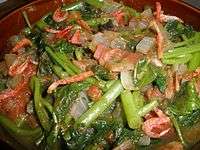
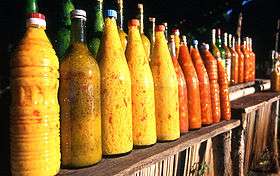
Malagasy cuisine: Two common Madagascan laokas: bambara groundnut and pork (left) and potato leaves with dried shrimp (center), usually served atop rice. On the right are bottles of lemon and mango sauces (achards), which are common in the northwestern coastal regions of Madagascar.[19]
- Mauritian cuisine
- Namibian cuisine is the cuisine of Namibia. It is influenced by the cookery practiced by indigenous people of Namibia and settler cookery introduced during the colonial period by people of German, Afrikaner and British descent.
- South African cuisine is sometimes called "rainbow cuisine", as it has had a variety of multicultural sources and stages. Influences include indigenous practices and settler cookery that immigrants practiced.
- Zimbabwean cuisine - Like in many African countries, the majority of Zimbabweans depend on a few staple foods. "mealie meal", also known as cornmeal, is used to prepare sadza or isitshwala and porridge known as bota or ilambazi.
West African cuisine
- West African cuisine refers to many distinct regional and ethnic cuisines in West African nations, a large geographic area with climates ranging from desert to tropical.[20] Some of the region's indigenous plants, such as hausa groundnuts, pigeon peas and cowpeas provide dietary protein for both people and livestock.[21] Many significant spices, stimulants and medicinal herbs originated in the evergreen and deciduous forests of Western Africa.[21] Ancient Africans domesticated the kola nut and coffee, now used globally in beverages.[21]
- Burkinabe cuisine is the cuisine of Burkina Faso. It is similar to the cuisines in many parts of West Africa, and is based around staple foods of sorghum, millet, rice, maize, peanuts, potatoes, beans, yams and okra.[22] Grilled meat is common, particularly mutton, goat, beef and fish.[23]
- Ghanaian cuisine is the cuisine of Ghana. There are diverse traditional dishes. Foods also vary according to the season, time of the day and occasion.
- Ivorian cuisine is the traditional cuisine of Côte d'Ivoire, or the Ivory Coast, and is based on tubers, grains, chicken, seafood, fish, fresh fruits, vegetables and spices and is very similar to that of neighboring countries in west Africa. Common staple foods include grains and tubers. Côte d'Ivoire is one of the largest cocoa producers in the world, and also produces palm oil and coffee.
- Nigerian cuisine - Like other West African cuisines, it uses spices and herbs in conjunction with palm oil or groundnut oil to create deeply flavored sauces and soups often made very hot with chili peppers. Nigerian feasts are colorful and lavish, while aromatic market and roadside snacks cooked on barbecues or fried in oil are plentiful and varied.[24]
- Sierra Leonean cuisine refers to the cuisine and eating styles found in the Republic of Sierra Leone, a country in West Africa. Sierra Leonean cuisine includes cassava bread, fried fish, and okra soup.
- Senegalese cuisine has been influenced by nations like France, Portugal, and those of North Africa, and also by many ethnic groups, the largest being the Wolof; Islam, which first penetrated the region in the 11th century; and various European cultures, especially the French, who held the country as a colony until 1960.
- African foods and dishes
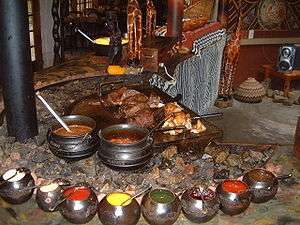 Traditional South African cuisine
Traditional South African cuisine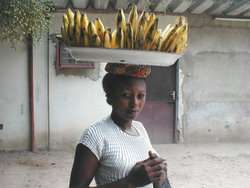 A woman carrying bananas in the Democratic Republic of the Congo
A woman carrying bananas in the Democratic Republic of the Congo- Central market of Léo, Burkina Faso
By country

Spices at central market in Agadir, Morocco

A map of Africa
- Angolan cuisine is the cuisine of Angola, a country in south-central Africa. Because Angola was a Portuguese colony for centuries, Portuguese cuisine has significantly influenced Angolan cuisine, with many foods imported into Angola by the Portuguese.[25]
- Benin cuisine is known in Africa for its and exotic ingredients and flavorful dishes. Beninese cuisine involves lots of fresh meals served with a variety of sauces. Meat is usually quite expensive, and meals are generally light on meat and generous on vegetable fat.
- Cape Verde - The Cape Verde diet is mostly based on fish and staple foods like corn and rice. Vegetables available during most of the year are potatoes, onions, tomatoes, manioc, cabbage, kale, and dried beans. Fruits such as banana and papayas are available year-round, while others like mangos and avocados are seasonal.
- Centrafrican (Central African Republic) is the cooking traditions, practices, foods and dishes associated with the Central African Republic. The diet is heavy on staple starches such as millet and sorghum, and utilizes a significant amount of vegetables and sauces.[26]
- Chadian cuisine is the cooking traditions, practices, foods and dishes associated with the Republic of Chad. Chadians utilize a variety of grains, vegetables, fruits and meats. Commonly consumed grains include millet, sorghum and rice as staple foods.
- Comoros
- The Republic of the Congo
- Djiboutian cuisine
- Equatorial Guinean cuisine
- Gabonese cuisine is the cooking traditions, practices, foods and dishes associated with the sovereign state of Gabon. French cuisine is prevalent as a notable influence, and in larger cities various French specialties are available.[27] In rural areas, food staples such as cassava, rice and yams are commonly used.[26][28]
- Gambian cuisine
- Guinean cuisine
- Guinea-Bissauan cuisine
- Lesothoan cuisine
- Liberian cuisine
- Malagasy cuisine encompasses the many diverse culinary traditions of the Indian Ocean island of Madagascar.
- Cuisine of Malawi
- Cuisine of Mali
- Cuisine of Mauritania
- Cuisine of Mauritius
- Mozambique - Present for nearly 500 years, the Portuguese greatly impacted the cuisine of Mozambique. Crops such as cassava (a starchy root) and cashew nuts (Mozambique was once the largest producer of these nuts), and pãozinho (pronounced pow-zing-yo; Portuguese-style bread rolls) were brought in by the Portuguese.
- The Cuisine of Niger reflects many traditional African cuisines, and a significant amount of spices are used in dishes. Grilled meats, seasonal vegetables, salads and various sauces are some of the foods consumed.
- Rwandan cuisine is based on local staple foods produced by the traditional subsistence-level agriculture and has historically varied between the country's different ethnic groups.[29]
- São Tomé and Príncipe
- Seychellois cuisine
- Cuisine of Swaziland is largely determined by the seasons and the geographical region. Staple foods in Swaziland include sorghum and maize,[30] often served with goat meat, a very popular livestock there.[31]
- Togolese cuisine is the cuisine of the Togolese Republic, a country in Western Africa. It is often a combination of African, French and German cuisines.[32] The cuisine has many sauces and pâtés, many of which are made from eggplant, tomato, spinach and fish.
- Western Saharan cuisine
- Zambian cuisine - The Zambian staple diet is based on maize. It is normally eaten as a thick porridge, called Nshima (Nyanja Word), prepared from maize flour commonly known as mealie meal. This may be eaten with a variety of vegetables, beans, meat, fish or sour milk depending on geographical location/origin.
See also
References
- ↑ "Cuisine." Thefreedictionary.com. Accessed June 2011.
- ↑ Bea Sandler (1993). The African Cookbook. Diane and Leo Dillon (Illust.). Carol Publishing Group. ISBN 0-8065-1398-5. Retrieved 2008-12-18.
- 1 2 3 4 5 6 "Food in Africa." World-food-and-wine.com. Accessed July 2011.
- ↑ Robert, Nassau Hamill (1904). "Fetichism in West Africa: Forty Years' Observation of Native Customs and Superstitions." Congocookbook.com. Accessed July 2011.
- ↑ United Nations Statistics Division – Standard Country and Area Codes Classifications
- ↑ Sandra Fullerton Joireman, Institutional Change in the Horn of Africa, (Universal-Publishers: 1997), p.1: "The Horn of Africa encompasses the countries of Ethiopia, Eritrea, Djibouti and Somalia. These countries share similar peoples, languages, and geographical endowments."
- 1 2 "Eritrean Food Practices." Webcitation.org. Accessed July 2011.
- 1 2 3 4 Javins, Marie. "Eating and Drinking in Ethiopia." Gonomad.com. Accessed July 2011.
- ↑ "Somali Halwa." Mysomalifood.com. Accessed July 2011.
- ↑ Barlin Ali, Somali Cuisine, (AuthorHouse: 2007), p.79
- ↑ "Nile Perch." Aquaticcommunity.com. Accessed July 2011.
- ↑ Kaufman, Les. "Catastrophic Change in Species-Rich Freshwater Ecosystems: The lessons of Lake Victoria". BioScience. 42 (11). doi:10.2307/1312084.
- ↑ Wood (1983). The Guinness Book of Animal Facts and Feats. Sterling Pub Co Inc. ISBN 978-0-85112-235-9.
- ↑ "Northern Africa." Foodspring.com. Accessed June 2011.
- ↑ Mourad, Mazouz. "The Momo Cookbook." The Globalist. Accessed June 2011.
- ↑ "Rainbow Cuisine in South Africa." Road Travel – Travel Group. Accessed July 2011.
- 1 2 3 "Madagascar." African Studies Center, University of Pennsylvania. Accessed July 2011.
- ↑ Bradt, Hilary (2011). Madagascar (10th ed.). Guilford, Connecticut: The Globe Pequot Press Inc. pp. 12–14. ISBN 978-1-84162-341-2.
- ↑ Espagne-Ravo, Angéline (1997). Ma Cuisine Malgache: Karibo Sakafo (in French). Paris: Edisud. ISBN 2-85744-946-1.
- ↑ "Africa Climate." Backpack Traveller. Accessed July 2011.
- 1 2 3 "Food and the African Past." Ucpress.edu. p. 14.
- ↑ "Oxfam's Cool Planet - Food in Burkina Faso". Oxfam. Retrieved 2008-05-21.
- ↑ Marchais, p. 99
- ↑ H.O. Anthonio & M. Isoun: "Nigerian Cookbook." Macmillan, Lagos, 1982.
- ↑ Adebayo Oyebade, Culture and Customs of Angola (2007). Greenwood, p. 109.
- 1 2 "Central African Republic." Foodspring.com. Accessed June 2011.
- ↑ "Gabon." Foodspring.com. Accessed June 2011.
- ↑ "Gabon." Worldtraveltips.net. Accessed June 2011.
- ↑ Adekunle, p.81
- ↑ "Food habits of rural Swazi households" (PDF).
- ↑ "Swaziland Food and Drink".
- ↑ "Sharing the Secrets of Togo's Cuisine." Madison.com. Accessed July 2011.
Further reading
- Adekunle, Julius (2007). Culture and Customs of Rwanda. Greenwood Publishing Group. ISBN 0-313-33177-4.
This article is issued from Wikipedia - version of the 11/17/2016. The text is available under the Creative Commons Attribution/Share Alike but additional terms may apply for the media files.

